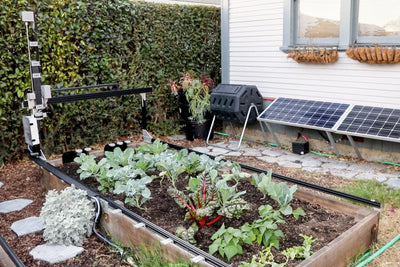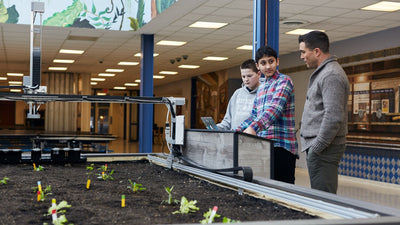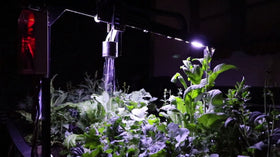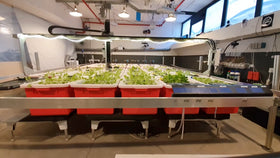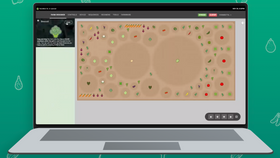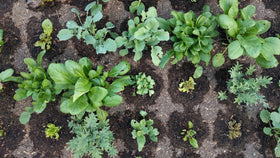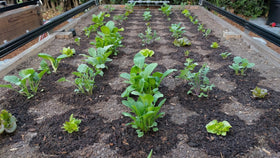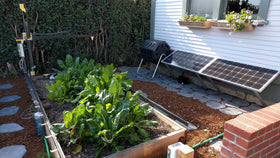We are often asked questions relating to FarmBot's yield.
"How big of a FarmBot do I need to grow all of my food?" is a common one. While we don't yet have any empirical data to share with you, we have done an analysis answering this very question. Let's dive in to see the results.
Gathering Data
We compiled a set of 33 common crops (seen in the table below) that could be compatible with FarmBot in the relative near future. You'll notice that we did not include tall crops such as sunflowers and corn, and there are no fruit trees or berry bushes (with the exception of strawberries). Additionally, there are no grain crops included because it is unlikely that growing grains would be efficient with FarmBot hardware in comparison to larger scale specialized equipment.
After choosing the crops, we needed to find three pieces of data for each: average yield per harvest (kg/m²/harvest), average days till harvest (days/harvest), and caloric density (calories/kg). We found this information from the USDA and a wide range of other sources online (see below for resources list).
Crunching Numbers
Right off the bat, we made an assumption that FarmBot can increase yield per harvest by about 12% by packing plants in a denser
hexagonal packing structure instead of a traditional
cubic packing structure. Using this new yield data and the days/harvest values, we calculated daily yield values for each crop in kg/m²/day. Multiplying this figure with the caloric density provided a daily caloric yield for each crop in calories/m²/day.
| Crop |
kg/m²/harvest (cubic packing) |
kg/m²/harvest (hexagonal packing) |
Days/harvest |
kg/m²/day |
Calories/kg |
Calories/m²/day |
| Artichoke |
1.23 |
1.42 |
120.00 |
0.0119 |
470 |
5.58 |
| Arugula |
0.79 |
0.91 |
35.00 |
0.0259 |
250 |
6.47 |
| Asparagus |
0.49 |
0.57 |
360.00 |
0.0016 |
200 |
0.32 |
| Beets |
1.57 |
1.81 |
60.00 |
0.0302 |
430 |
12.98 |
| Bell Pepper |
0.77 |
0.89 |
90.00 |
0.0099 |
250 |
2.48 |
| Black Beans |
0.16 |
0.18 |
85.00 |
0.0021 |
3390 |
7.23 |
| Broccoli |
1.18 |
1.36 |
65.00 |
0.0209 |
340 |
7.11 |
| Brussel Sprouts |
1.79 |
2.07 |
110.00 |
0.0188 |
430 |
8.09 |
| Cabbage |
3.53 |
4.08 |
90.00 |
0.0453 |
250 |
11.32 |
| Carrots |
3.36 |
3.88 |
70.00 |
0.0555 |
410 |
22.74 |
| Cauliflower |
1.35 |
1.55 |
80.00 |
0.0194 |
250 |
4.85 |
| Celery |
3.59 |
4.14 |
180.00 |
0.0230 |
160 |
3.68 |
| Chard |
1.68 |
1.94 |
50.00 |
0.0388 |
190 |
7.38 |
| Collards |
1.82 |
2.11 |
40.00 |
0.0527 |
320 |
16.85 |
| Cucumber |
1.96 |
2.27 |
60.00 |
0.0378 |
160 |
6.04 |
| Eggplant |
2.19 |
2.52 |
90.00 |
0.0280 |
250 |
7.01 |
| Garlic |
0.48 |
0.56 |
90.00 |
0.0062 |
1490 |
9.21 |
| Kale |
1.82 |
2.11 |
50.00 |
0.0421 |
490 |
20.64 |
| Kohlrabi |
1.63 |
1.88 |
65.00 |
0.0289 |
270 |
7.79 |
| Lettuce |
3.03 |
3.49 |
55.00 |
0.0635 |
150 |
9.53 |
| Melons |
1.68 |
1.94 |
90.00 |
0.0216 |
320 |
6.90 |
| Okra |
2.55 |
2.94 |
60.00 |
0.0491 |
330 |
16.19 |
| Onion |
4.32 |
4.98 |
110.00 |
0.0453 |
400 |
18.12 |
| Peas |
0.45 |
0.52 |
70.00 |
0.0074 |
810 |
5.99 |
| Potato |
1.92 |
2.21 |
110.00 |
0.0201 |
770 |
15.48 |
| Pumpkin |
4.48 |
5.18 |
110.00 |
0.0471 |
260 |
12.24 |
| Radish |
0.84 |
0.97 |
60.00 |
0.0162 |
160 |
2.59 |
| Spinach |
1.40 |
1.62 |
55.00 |
0.0294 |
230 |
6.77 |
| Squash |
3.92 |
4.53 |
90.00 |
0.0503 |
450 |
22.65 |
| Strawberries |
2.48 |
2.86 |
360.00 |
0.0079 |
330 |
2.62 |
| Tomato |
1.23 |
1.42 |
85.00 |
0.0167 |
180 |
3.01 |
| Turnip |
4.48 |
5.18 |
60.00 |
0.0863 |
280 |
24.16 |
| Zucchini |
3.36 |
3.88 |
90.00 |
0.0431 |
170 |
7.34 |
From here, we found out how many calories/day could be produced with a FarmBot Genesis (4.5 m² in size) and a FarmBot Genesis XL (18 m²). We calculated these values twice: once by using an average caloric yield of all 33 crops to represent growing them all using an equal amount of area; and once by using an average of the best 10 performing crops as ranked by the calories/m²/day benchmark. The results are in the table below:
|
Calories/m²/Day |
Calories/day with FarmBot Genesis |
Calories/day with FarmBot Genesis XL |
| All crops average |
9.74 |
44 |
175 |
| Best 10 average |
18.21 |
82 |
328 |
As you know, 328 calories/day with a Genesis XL growing the best 10 performing crops is not very many calories. Most people eat at least 2,000 calories/day. By this analysis, one would need a huge FarmBot to grow all of their caloric needs. We calculated just how big in the table below, revealing a minimum size of 110 square meters (the size of a small house) in order to provide all 2,000 calories/day.
|
Calories/m²/Day |
Size of FarmBot needed for a 2,000 calorie diet (m²) |
Size of FarmBot needed for a 2,500 calorie diet (m²) |
| All crops average |
9.74 |
205 |
257 |
| Best 10 average |
18.21 |
110 |
137 |
Cups, not Calories
But this isn't a very useful calculation because most people don't get 100% of their calories from vegetables. Not even close to it, actually. Most people also eat grains, dairy, meats, oils, fruits, etc - all of which are much more calorie dense than veggies. According to
My Plate (previously the food pyramid), we're supposed to eat about 3
cups of veggies a day, and there is no mention of calories of veggies at all.
This means that the question we are asking and answering should instead be:
"How big of a FarmBot would I need to grow the recommended cups/day of veggies I need?" Let's see how this changes things.
If you chose to eat 3 cups of black beans every day, that would be over 1,500 calories, and require about 250 square meters to grow. This is a huge amount of area needed to satisfy our 3 cups goal. If you chose to eat 3 cups of arugula every day (a crop with similar calorie/kg value to black beans), that would be less than 20 calories, and only require about 3 square meters to grow. This is a much smaller amount of area needed because our new goal is cups, not calories. So while both crops perform similarly according to the calorie benchmark, they perform extremely different under the cups benchmark.
Promising Results
Looking back out our table of 33 crops, with new columns for cups/m²/day, and FarmBot is looking quite a bit more feasible for satisfying our needs.
| Crop |
kg/m²/harvest (cubic packing) |
kg/m²/harvest (hexagonal packing) |
Days/harvest |
kg/m²/day |
cups/kg |
cups/m²/day |
| Artichoke |
1.23 |
1.42 |
120.00 |
0.0119 |
7.46 |
0.09 |
| Arugula |
0.79 |
0.91 |
35.00 |
0.0259 |
50.00 |
1.29 |
| Asparagus |
0.49 |
0.57 |
360.00 |
0.0016 |
7.46 |
0.01 |
| Beets |
1.57 |
1.81 |
60.00 |
0.0302 |
7.35 |
0.22 |
| Bell Pepper |
0.77 |
0.89 |
90.00 |
0.0099 |
8.33 |
0.08 |
| Black Beans |
0.16 |
0.18 |
85.00 |
0.0021 |
5.43 |
0.01 |
| Broccoli |
1.18 |
1.36 |
65.00 |
0.0209 |
10.99 |
0.23 |
| Brussel Sprouts |
1.79 |
2.07 |
110.00 |
0.0188 |
11.36 |
0.21 |
| Cabbage |
3.53 |
4.08 |
90.00 |
0.0453 |
14.29 |
0.65 |
| Carrots |
3.36 |
3.88 |
70.00 |
0.0555 |
8.70 |
0.48 |
| Cauliflower |
1.35 |
1.55 |
80.00 |
0.0194 |
9.35 |
0.18 |
| Celery |
3.59 |
4.14 |
180.00 |
0.0230 |
9.90 |
0.23 |
| Chard |
1.68 |
1.94 |
50.00 |
0.0388 |
27.78 |
1.08 |
| Collards |
1.82 |
2.11 |
40.00 |
0.0527 |
27.78 |
1.46 |
| Cucumber |
1.96 |
2.27 |
60.00 |
0.0378 |
9.62 |
0.36 |
| Eggplant |
2.19 |
2.52 |
90.00 |
0.0280 |
12.20 |
0.34 |
| Garlic |
0.48 |
0.56 |
90.00 |
0.0062 |
7.35 |
0.05 |
| Kale |
1.82 |
2.11 |
50.00 |
0.0421 |
14.93 |
0.63 |
| Kohlrabi |
1.63 |
1.88 |
65.00 |
0.0289 |
7.41 |
0.21 |
| Lettuce |
3.03 |
3.49 |
55.00 |
0.0635 |
27.78 |
1.76 |
| Melons |
1.68 |
1.94 |
90.00 |
0.0216 |
5.88 |
0.13 |
| Okra |
2.55 |
2.94 |
60.00 |
0.0491 |
10.00 |
0.49 |
| Onion |
4.32 |
4.98 |
110.00 |
0.0453 |
6.25 |
0.28 |
| Peas |
0.45 |
0.52 |
70.00 |
0.0074 |
6.90 |
0.05 |
| Potato |
1.92 |
2.21 |
110.00 |
0.0201 |
6.67 |
0.13 |
| Pumpkin |
4.48 |
5.18 |
110.00 |
0.0471 |
8.62 |
0.41 |
| Radish |
0.84 |
0.97 |
60.00 |
0.0162 |
8.62 |
0.14 |
| Spinach |
1.40 |
1.62 |
55.00 |
0.0294 |
33.33 |
0.98 |
| Squash |
3.92 |
4.53 |
90.00 |
0.0503 |
8.06 |
0.41 |
| Strawberries |
2.48 |
2.86 |
360.00 |
0.0079 |
6.94 |
0.06 |
| Tomato |
1.23 |
1.42 |
85.00 |
0.0167 |
5.56 |
0.09 |
| Turnip |
4.48 |
5.18 |
60.00 |
0.0863 |
7.69 |
0.66 |
| Zucchini |
3.36 |
3.88 |
90.00 |
0.0431 |
8.06 |
0.35 |
Using the average yield for our 33 crops, and an assumption that they will all be grown in equal quantities, one only needs about 7 square meters of space to grow the daily recommended veggies for one person. If one decides to grow only the top 10 performers (by the cups/m²/day benchmark), then they will only need
3 square meters to grow all of their daily veggies.
This indicates that FarmBot Genesis could produce all of the veggies needed for one person every day. Meanwhile, a Genesis XL could produce enough veggies for a family of four every day. See the table below for the numbers:
|
cups/m²/day |
cups/day with FarmBot Genesis |
cups/day with FarmBot Genesis XL |
| All crops average |
0.42 |
1.88 |
7.51 |
| Best 10 average |
1.00 |
4.51 |
18.02 |
We think that this data is quite promising for the FarmBot Project because it shows the capabilities of FarmBot in a clear and transparent light. Your FarmBot (unless it is very large) will
not be able to produce all of your
calories. However, it
will be able to produce enough
cups of vegetables to satisfy your daily needs.
What do you think of our analysis? We'd love to hear your feedback and ideas in the comments.
Resources used
Caloric density data from the USDA:
http://ndb.nal.usda.gov/ndb/foods
Average yield data from the following sources:
http://www.johnnyseeds.com/assets/information/vegetablecharts.pdf
Wolfram|Alpha Knowledgebase, 2015
http://www.gardensofeden.org/04%20Crop%20Yield%20Verification.htm
http://www.lsuagcenter.com/en/lawn_garden/home_gardening/vegetables/Expected+Vegetable+Garden+Yields.htm
http://aggie-horticulture.tamu.edu/vegetable/files/2011/10/swisschard.pdf
http://anrcatalog.ucanr.edu/pdf/7221.pdf
http://edgecombe.ces.ncsu.edu/files/library/33/production%20data%20table%20edit[1].pdf
Days to harvest data from the following sources:
http://www.ipm.iastate.edu/ipm/hortnews/2004/7-23-2004/vegguide.html
http://www.harvesttotable.com/2010/06/vegetable_harvest_times/
Recommended daily vegetable intake value from My Plate:
http://www.choosemyplate.gov/vegetables

